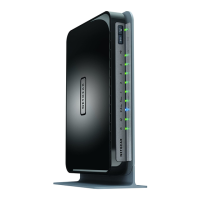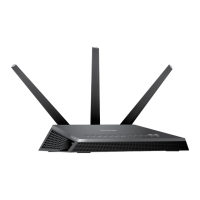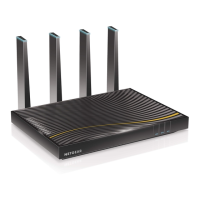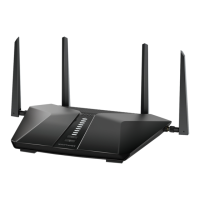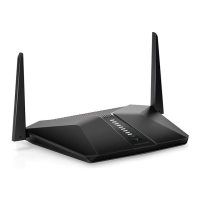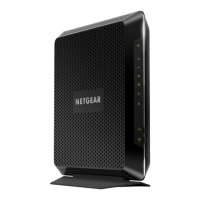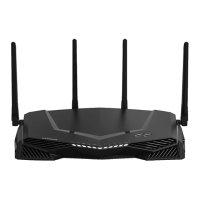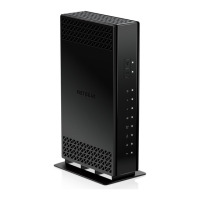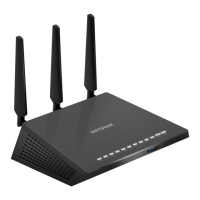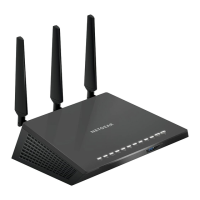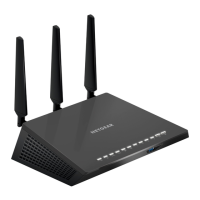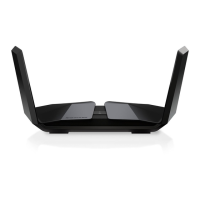Do you have a question about the NETGEAR N150 and is the answer not in the manual?
| WiFi Technology | 802.11n |
|---|---|
| WiFi Speed | Up to 150 Mbps |
| Frequency Band | 2.4 GHz |
| Model | N150 |
| Ethernet Ports | 4 x 10/100 Mbps |
| Security | WPA/WPA2-PSK |
| Antenna | Internal |
| Weight | 0.66 lbs |
Details the items included in the router box for initial setup.
Describes the router's physical components, labels, and indicators.
Details the ports and buttons located on the rear of the router.
Explains the status LEDs and icons on the router's front panel.
Provides guidance on optimal placement for wireless signal strength.
Explains the purpose and use of ADSL microfilters for DSL connections.
Provides step-by-step instructions for connecting the router hardware.
Guides users on how to confirm correct physical connections using router LEDs.
Outlines prerequisites and necessary information before configuring the router.
Details the recommended setup process using the NETGEAR Genie software.
Explains how to access the router's web interface for configuration.
Describes the process for updating the router's firmware for performance and security.
Provides an overview of the router's web interface layout and navigation.
Details the step-by-step wizard for configuring the Internet connection.
Explains how to manually configure basic Internet connection settings.
Covers specific configuration parameters for DSL Internet connections.
Offers troubleshooting steps for when the Internet connection fails.
Guides on securing the router by changing the administrator password and timeout.
Clarifies the different types of login credentials used by the router and ISP.
Explains the pre-configured Wi-Fi network name (SSID) and passphrase.
Introduces fundamental wireless security concepts and features.
Details methods for connecting wireless devices to the router.
Describes connecting wireless devices manually using SSID and passphrase.
Explains the WPS method for simplified and secure device connection.
Covers the interface for viewing and modifying wireless network configurations.
Instructs on how to view and adjust wireless network name, security, and channel.
Details configuration options like SSID, Region, Channel, and Mode.
Covers settings related to the router's function as a wireless access point.
Explains how to restrict network access based on MAC addresses.
Guides on modifying wireless encryption type and network password.
Details the configuration for WEP encryption, an older security standard.
Explains how to block specific websites or domains based on keywords.
Describes how to configure firewall rules for inbound and outbound traffic.
Details how to configure port forwarding to allow external access to internal services.
Provides instructions for creating custom firewall exceptions and managing rule precedence.
Explains how to block specific Internet services or applications from local computers.
Guides on defining custom services and port numbers for firewall rules.
Explains how to set the router's time zone for accurate logging and scheduling.
Covers setting up schedules for enabling or disabling firewall rules and services.
Details how to configure email alerts for security events and log notifications.
Covers the critical process of updating the router's firmware.
Explains how to manually check for and download new firmware versions.
Details how to back up, restore, or erase router configuration settings.
Instructs on saving the current router configuration settings to a file.
Guides on loading previously saved configuration settings.
Describes how to reset the router to its factory default settings.
Explains how to check the current operational status and statistics of the router.
Shows how to view a list of devices currently connected to the router's network.
Details tools for testing network connectivity, DNS resolution, and routing.
Configures Internet connection parameters, including DMZ and MTU settings.
Explains how to use dynamic DNS services for remote access with changing IP addresses.
Covers configuration of local network settings, IP addresses, and DHCP.
Details how to assign static IP addresses to specific devices on the LAN.
Provides access to advanced wireless configuration options.
Enables remote configuration and monitoring of the router over the Internet.
Explains how to manually configure routing information for complex network setups.
Covers UPnP settings for automatic device discovery and network resource sharing.
Guides on diagnosing issues when the router does not power on.
Troubleshoots scenarios where the router's power LED is not lit.
Addresses problems indicated by a red power LED, suggesting a fault.
Helps diagnose issues when the LAN or DSL link LEDs are not active.
Provides steps to resolve problems preventing Internet access.
Explains how to interpret the DSL link status LEDs for connection issues.
Troubleshoots the scenario where the Internet LED indicates no connection.
Guides on resolving issues related to the router failing to get an IP address from the ISP.
Offers methods to debug PPPoE or PPPoA connection problems.
Helps diagnose why web pages fail to load despite having an IP address.
Addresses issues where the TCP/IP network appears unresponsive.
Explains how to ping the router to verify local network connectivity.
Provides solutions for inability to log in to the router's interface.
Troubleshoots issues where router configuration changes are not saved.
Guides on recovering from firmware issues requiring a reload.
Addresses issues with the router's displayed date and time settings.
Lists the default configuration parameters of the router.
Provides detailed hardware specifications, including dimensions, weight, and operating conditions.
Details FCC regulations for product operation and compliance in the US.
States the manufacturer's declaration of the product's compliance with FCC rules.
Provides guidelines and warnings regarding radio frequency interference.
Outlines Canadian regulations for radio interference from digital apparatus.
Declares compliance with European Union directives for radio equipment.
Lists recommended minimum distances from appliances to reduce RF interference.
